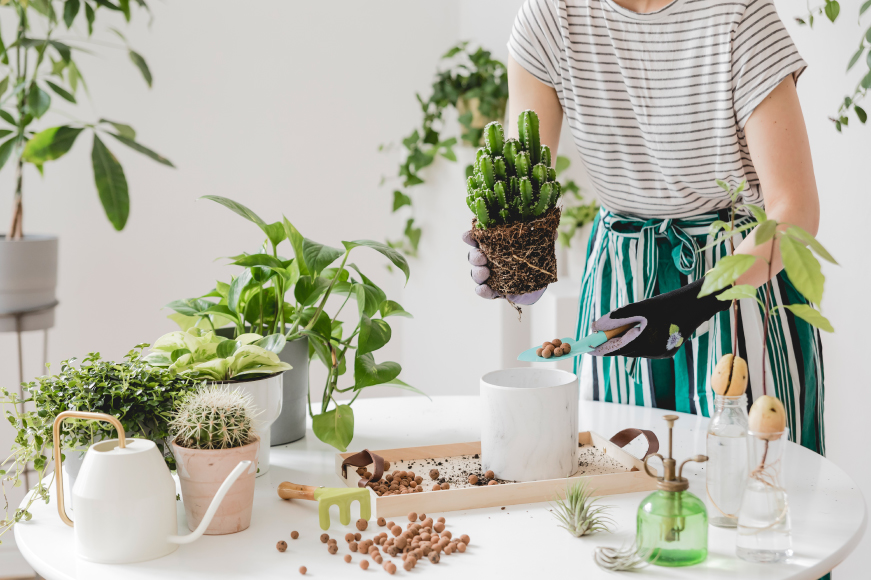
Well, spring has come, and with it spring chores. Plant lovers have a hot season now - preparing plants for the summer season. If you have organized the wintering of your green friends correctly, then now they are just waiting for the onset of warmth to please you again with wild growth and luxurious flowering. But before that, they will have to go through a replacement or renewal of the soil, and some will also have to transplant into new pots.
How to choose the right soil and plant pot?
• The size of the pot is selected according to the size of the root ball, not the aerial part of the plant. If during the last season or as a result of winter maintenance or illness, some of the roots died off, it may even need to be transplanted into a smaller container. You should never choose a pot "for growth", because at the same time, the conditions for root development deteriorate and the plants get sick. In the case when there is no need to change the pot and the roots are still comfortably placed, it is still necessary to update the potting mix. To do this, we place the plant in the same pot, slightly shaking off the old soil from the roots, and replacing it with a new, nutritious one.
• The choice of soil. In flower shops you can buy ready-made flower mixes. Experienced gardeners can prepare them on their own using commercially available peat mixtures, leaf soil, as well as additives - perlite, vermiculite, coconut fiber. The main thing to pay attention to when it comes to soil is the declared acidity. Most indoor plants feel comfortable in soils with a slightly acidic pH = 5.5-6.5. Some (camellia, blue hydrangea, gardenia, azalea, erica, rhododendron) require an earthen mixture with a pH of 5.0 and below.
Another important question that you can decide at the stage of choosing a soil is how much time you can devote to caring for your plants and how regular it can be.
Perhaps your collection is dominated by plants that are recommended to be watered only after complete or partial drying of the soil (these are cacti and other succulent plants). They will calmly forgive you the long break between watering.
But what if you have plants that require uniform, regular soil moisture (after the top layer of 3-4 cm dries out)? These are, first of all, ornamental-leaved plants that came to us from tropical forests: aglaonema, dieffenbachia, ficus, dracaena, calathea, ferns, etc. Overdue watering for them will affect a sharp loss of decorativeness - yellowing and dropping (wilting) of leaves.
If you are not sure that you can regularly pay attention to caring for such plants, a hydrogel will come to your rescue. This is a great invention for the constantly traveling and business people. In this case, pre-soaked hydrogel granules are added to the soil mixture of your choice. For planting, approximately 1 g of dry granules per 1 liter of soil are used. Hydrogel granules are poured with clean water or a weak solution of complex fertilizer and left for several hours. 1 g of hydrogel absorbs about 200 mg of water. As a result of contact with liquid, the hydrogel swells and increases in volume several times. Excess water is drained, and the swollen hydrogel is mixed with the prepared soil. Now your substrate is completely ready for planting or transplanting plants. Such a soil perfectly retains moisture and nourishes the roots with occasional watering. The roots perfectly penetrate the material and receive moisture from it for a long time. With the next watering, the depleted hydrogel granules again absorb a large amount of water, protecting the soil from acidification during excessive watering.
What else do you need to know about pots?
As noted above, the pot is selected according to the size of the root system: a drainage layer (up to 1/5 of the height of the pot) of inert material (crushed stone, expanded clay) should fit in it at the bottom, and then an earthen lump should be freely located. When planting in a large pot, it is recommended to add a lightening material to the soil mixture - expanded clay.
Sometimes there are situations when, for reasons of decorative effect, it is required to visually combine a plant with a pot that is many times larger than the required one. The way out is to use a pots with inner container, but choose it according to the size of the plant.
If the plant is large and does not require replanting, you can renew the soil by carefully removing the top 10-12 cm of the old soil and add fresh soil.
If you do not plan to carry out "earthworks" at all, for the successful development of the plant, you can use fertilizers - from April to September, feed your plants with universal compounds, alternating organic and mineral fertilizers in strict accordance with the instructions.
As you can see, your green friends don't need much attention to make them feel good and please you. And on our website you will find everything you need for this - gardening tools, pots and pots with a container, expanded clay, various earthen mixtures, perlite and vermiculite.
“Domino” wishes you all the best!
Recent posts
- Tools for your yard: what you absolutely need
- როგორ შევარჩიოთ უნიტაზი - რჩევები და ტენდენციები
- Top Tools for Every Household
- რა უნდა ვიცოდეთ ნიჟარის შერჩევის დროს
- როგორ შევარჩიოთ შესაფერისი პლინტუსი იატაკისთვის
- იატაკის საფარის გადაბმა - რჩევები საუკეთესო გადაწყვეტილებისთვის
- ცივი, თბილი თუ ნეიტრალური - როგორ შევარჩიოთ განათება
- როგორ შევარჩიოთ ფილა სამზარეულოს წინსაფრისთვის
- საღებავი თუ შპალერი — როგორ შევარჩიოთ კედლის საფარი
- როგორ დავგეგმოთ პრაქტიკული და კომფორტული შემოსასვლელი










